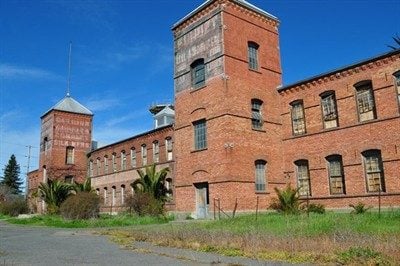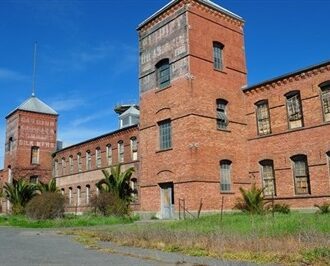Petaluma Silk Mill Historic Roof Restoration
Marin County, Sonoma County, San Francisco and Napa
Wedge Roofing’s Historic Roof Restoration of the Petaluma Silk Mill Spans Decades
Petaluma Silk Mill | Built 1892 | National Register of Historic Places #860000386
Wedge Roofing’s historic roof restoration of the Petaluma Silk Mill spans nearly four decades, beginning in 1986, the same year the building was listed on the National Register of Historic Places. That initial work marked the start of a long-term relationship with one of Petaluma’s most important historic structures—work that continued with additional repairs in 2023.
Primarily constructed in 1892 this Georgian Colonial Revival style textile mill was in continuous use for over 115 years. When Wedge Roofing was first called in, the building had been abandoned for years, and the original tin-plate standing seam metal roof showed signs of severe rust and corrosion. Interior water intrusion was actively damaging the structure, threatening the historic fabric of the mill. In alignment with national preservation standards, Wedge’s early efforts focused on stabilizing the roof—a crucial step in preventing further structural deterioration and ensuring the mill’s future restorability. Corroded areas were treated, protective coatings applied, and key roof components like the towers and cupolas were preserved in place. This work helped halt further damage during a critical time in the building’s history.
In 2023, Wedge Roofing returned to the Silk Mill—now operating as the Hampton Inn Petaluma—to complete metal roof repairs on one of its three-story towers. A crane was used to access elevated portions of the structure, where sections of the metal roof were restored, ensuring continued protection while maintaining the building’s historic profile.
History of the Petaluma Silk Mill
Built in 1892, the Petaluma Silk Mill originally housed the Carlson-Currier Silk Manufacturing Company, part of California’s broader push in the late 19th century to develop local industry. Its arrival in Petaluma was the result of a successful community campaign to attract the factory from San Francisco. The building was designed by noted architect Charles I. Havens, with later expansions in 1906 and 1922 by Brainerd Jones, one of Petaluma’s most prominent early 20th-century architects.
The original structure included a central tower and was half the length of the current building. Following the 1906 earthquake, the north wing was added, and in 1922 the south wing and a second tower completed the form we see today. Subtle changes in brick color reflect these different phases of construction.
Over the years, the mill produced high-quality silk thread and sewing products, later transitioning under the Sunset Line & Twine Company to manufacturing silk and synthetic fishing lines, and eventually, industrial cords and tapes.
Though the building fell into disrepair in the late 20th century, its industrial legacy and architectural significance led to its historic designation in 1986. After decades of vacancy, it was revitalized by Perry and Linda Patel of BPR Petaluma Properties LLC and reopened in 2018 as a 75-room Hampton Inn.Thanks to the vision of developers Perry and Linda Patel, the Petaluma Silk Mill has been reimagined as a vibrant hotel. But its soul—the brick walls, the iconic towers, and yes, the historic roof—remains intact, safeguarded through the years by Wedge Roofing’s expert touch.


